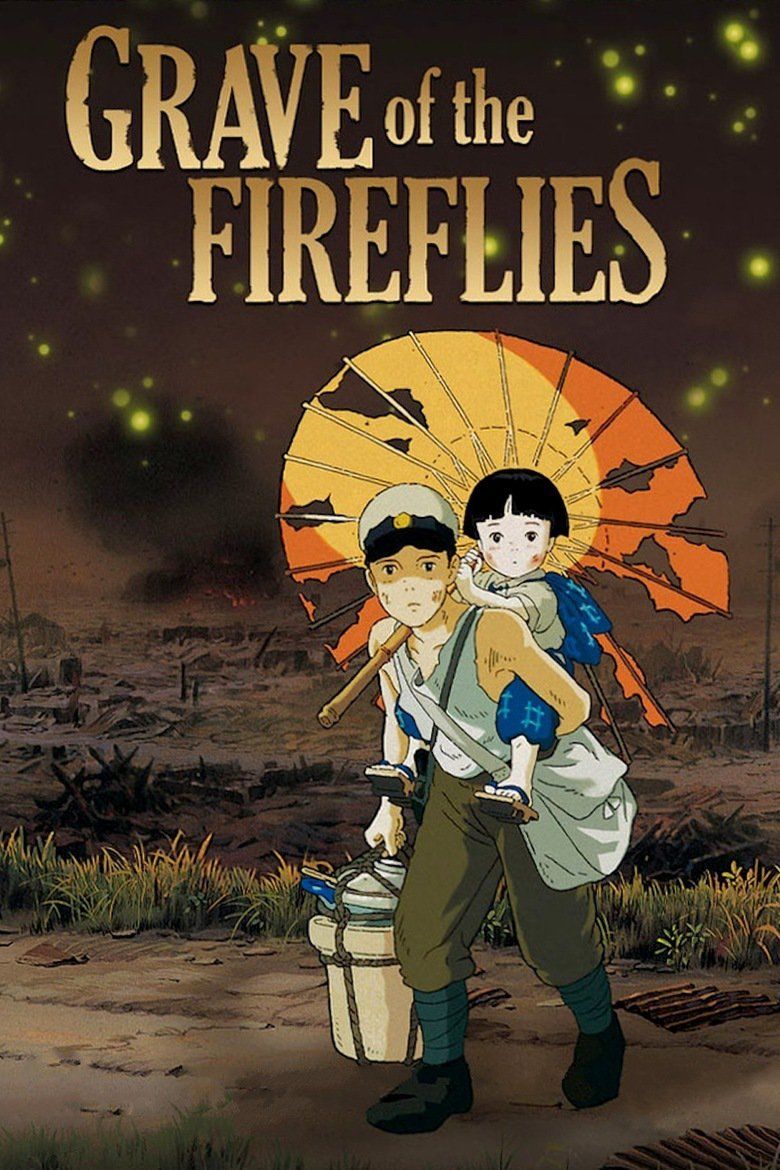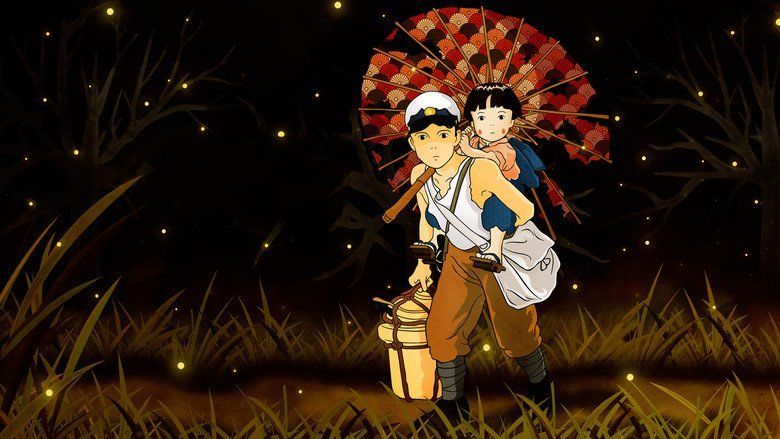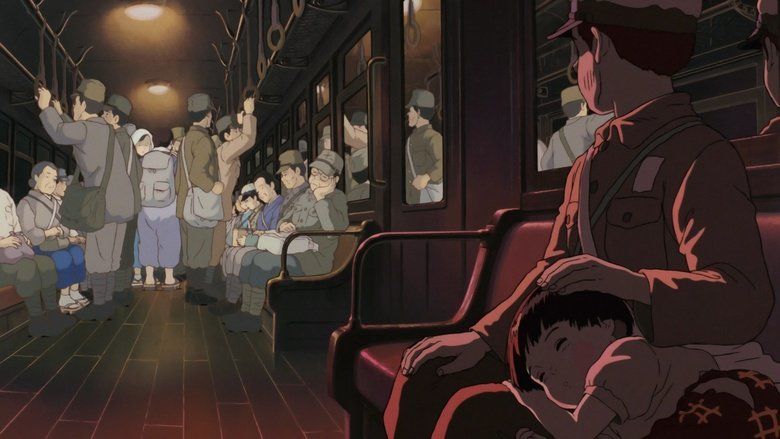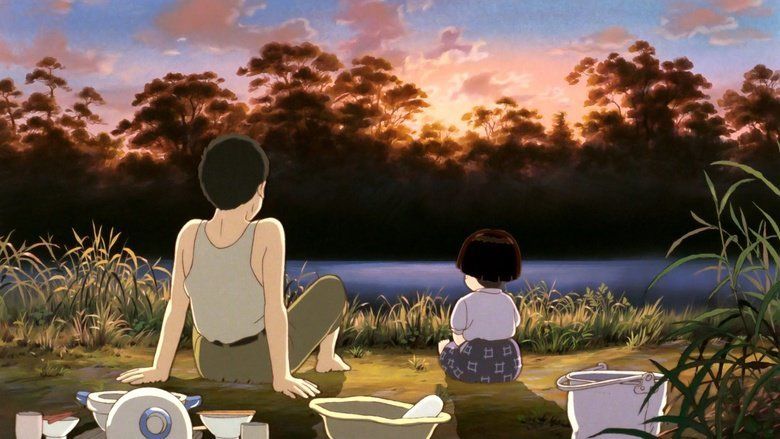Grave of the Fireflies
9.2 /10 1 Votes
4/4 Roger Ebert 97% Rotten Tomatoes Genre Animation, Drama, War Duration | 8.5/10 IMDb 8.6/10 MyAnimeList Featured song Home! Sweet Home! Country Japan | |||||||||||||||||||||||||||||||||
 | ||||||||||||||||||||||||||||||||||
Release date April 16, 1988 (1988-04-16) Similar movies Saving Private Ryan , The Pianist , Max Manus: Man of War , The Thin Red Line , The Great Escape , Memoirs of a Geisha | ||||||||||||||||||||||||||||||||||
Grave of the fireflies official trailer
Grave of the Fireflies (火垂るの墓, Hotaru no Haka) is a 1988 Japanese animated war drama film written and directed by Isao Takahata and animated by Studio Ghibli. It is based on the 1967 semi-autobiographical short story Grave of the Fireflies by Akiyuki Nosaka. The film stars Tsutomu Tatsumi, Ayano Shiraishi, Yoshiko Shinohara and Akemi Yamaguchi. Set in the city of Kobe, Japan, the film tells the story of two siblings, Seita and Setsuko, and their desperate struggle to survive during the final months of the Second World War.
Contents
- Grave of the fireflies official trailer
- Film critic roger ebert grave of the fireflies
- Plot
- Development
- Music
- Themes and analysis
- Release
- Home media
- Reception
- 2005 live action version
- 2008 live action version
- References

The film was critically acclaimed. Roger Ebert of the Chicago Sun-Times considered it to be one of the best and most powerful war films and, in 2000, included it on his "Great Movies" list. Two live-action remakes of Grave of the Fireflies were made, one in 2005 and one in 2008. It is commonly described as an anti-war film, but this interpretation has been denied by the director.

Film critic roger ebert grave of the fireflies
Plot

The film begins at Sannomiya Station on 21 September 1945, shortly after the end of World War II. A boy, Seita (清太), is shown dying of starvation. Later that night, having removed Seita's body, a janitor digs through his possessions and finds a candy tin which he throws away into a nearby field. The spirit of Seita's younger sister, Setsuko (節子), springs from the tin and is joined by Seita's spirit as well as a cloud of fireflies. Seita's spirit then begins to narrate their story accompanied by an extended flashback of the final months of World War II.

The flashback begins in Kobe on 16–17 March 1945, with a fleet of several hundred American B-29 Superfortress bombers flying overhead. Setsuko and Seita, the two siblings, are left to secure the house and their belongings, allowing their mother, who suffers from a heart condition, to reach a bomb shelter. They are caught off-guard as the bombers begin to drop thousands of incendiary bomblets, which start huge fires that quickly destroy their neighborhood and most of the city. Although they survive unscathed, their mother is horribly burned and dies a short time later. Having nowhere else to go, Setsuko and Seita move in with a distant aunt, who allows them to stay but convinces Seita to sell his mother's kimonos for rice. While living with their relatives, Seita goes out to retrieve supplies he had buried before the bombing. He gives them all to his aunt but hides a small tin of Sakuma fruit drops, which becomes a recurrent icon throughout the film. Their aunt continues to shelter them alongside her daughter and a local worker, but as food rations continue to shrink, she becomes increasingly resentful and openly remarks on how they do nothing to earn the food she cooks.

Seita and Setsuko finally decide to leave and move into an abandoned bomb shelter. They release fireflies into the shelter for light. The next day, Setsuko is horrified to find that the insects have all died. She buries them all in a grave, asking why they had to die, and why her mother had to die. What began as a new lease on life grows grim as they run out of rice, forcing Seita to steal from local farmers and loot homes during air raids. When he is caught, he realizes his desperation and takes an increasingly ill Setsuko to a doctor, who informs him that Setsuko is suffering from malnutrition but offers no help. In a panic, Seita withdraws all the money remaining in their mother's bank account, but as he leaves the bank, he becomes distraught when he learns from a nearby crowd that Japan has surrendered unconditionally to the Allied Powers. He also learns that his father, a captain in the Imperial Japanese Navy aboard a cruiser, is probably dead, since nearly all of Japan's navy is now at the bottom of the ocean. He returns to the shelter with a large quantity of food, only to find a dying Setsuko hallucinating. Seita hurries to cook, but she dies soon after. Seita cremates Setsuko's body, and puts her ashes in the fruit tin, which he carries along with his father's photograph, until his own death from malnutrition in Sannomiya Station a few weeks later.
In the final scene, the spirits of Seita and Setsuko are seen healthy, well-dressed and happy as they sit together, surrounded by fireflies. The camera then moves overhead, showing the two of them looking down on the then present day city of Kobe.
Development
Grave of the Fireflies author Akiyuki Nosaka said that many offers had been made to create a film version of Grave of the Fireflies. Nosaka argued that "[i]t was impossible to create the barren, scorched earth that's to be the backdrop of the story." He also argued that contemporary children would not be able to convincingly play the characters. Nosaka expressed surprise when an animated version was offered. After seeing the storyboards, Nosaka concluded that it was not possible for such a story to have been made in any method other than animation and expressed surprise in how accurately the rice paddies and townscape were depicted.
Isao Takahata said that he was compelled to film the short story after seeing how the main character, Seita, "was a unique wartime ninth grader." Takahata explained that any wartime story, whether animated or not animated, "tends to be moving and tear-jerking," and that young people develop an "inferiority complex" where they perceive people in wartime eras as being more noble and more able than they are, and therefore the audience believes that the story has nothing to do with them. Takahata argued that he wanted to dispel this mindset. When Nosaka asked if the film characters were "having fun," Takahata answered that he clearly depicted Seita and Setsuko had "substantial" days and that they were "enjoying their days." Takahata said that Setsuko was even more difficult to animate than Seita, and that he had never before depicted a girl younger than five. Takahata said that "[i]n that respect, when you make the book into a movie, Setsuko becomes a tangible person," and said that four-year-olds often become more assertive, self-centered, and try to get their own ways during their ages, and he explained that while one could "have a scene where Seita can't stand that anymore," "that's difficult to incorporate into a story." Takahata explained that the film is from Seita's point of view, "and even objective passages are filtered through his feelings"
Takahata said that he had considered using non-traditional animation methods, but because "the schedule was planned and the movie's release date set, and the staff assembled, it was apparent there was no room for such a trial-and-error approach." Takahata said that he had difficulty animating the scenery since, in Japanese animation, one is "not allowed" to depict Japan in a realistic manner. Animators often traveled to foreign countries to do research on how to depict them, but such research had not been done before for a Japanese setting.
Most of the illustration outlines in the film are in brown, instead of the customary black. Whenever black was used, it was only used when it was absolutely necessary. Color coordinator Michiyo Yasuda said this was done to give the film a softer feel. Yasuda said that until that point it had never been used in an anime before, "and it was done on a challenge." Yasuda explained that brown is more difficult to use than black because it does not contrast as well as black.
Music
The film score was composed by Michio Mamiya. Mamiya is also a music specialist in baroque and classical music. The song Home Sweet Home was performed by coloratura soprano Amelita Galli-Curci.
Themes and analysis
Some critics in the West have viewed Grave of the Fireflies as an anti-war film due to the graphic and emotional depiction of the pernicious repercussions of war on a society, and the individuals therein. The film focuses its attention almost entirely on the personal tragedies that war gives rise to, rather than seeking to glamorize it as a heroic struggle between competing nations. It emphasizes that war is society's failure to perform its most important duty: to protect its own people.
However, director Takahata repeatedly denied that the film was an anti-war film. In his own words, "[The film] is not at all an anti-war anime and contains absolutely no such message." Instead, Takahata had intended to convey an image of the brother and sister living a failed life due to isolation from society and invoke sympathy particularly in people in their teens and twenties.
Since the film gives little context to the war, Takahata fears a politician could just as easily claim fighting is needed to avoid such tragedies. In general, he is skeptical depictions of suffering in similar works, such as Barefoot Gen, actually prevent aggression. The director is nevertheless an anti-war advocate and a staunch supporter of Article 9 of the Japanese Constitution who has openly criticized Japan's penchant for conformity, allowing them to be rallied against other nations. He has expressed despair and anxiety whenever the youth are told to fall in line, a reminder that the country at its core has not changed.
Release
The film was released on 16 April 1988, over 20 years from the publication of the short story.
The initial Japanese theatrical release was accompanied by Hayao Miyazaki's lighthearted My Neighbor Totoro as a double feature. The release was a box office failure. While the two films were marketed toward children and their parents, the starkly tragic nature of Grave of the Fireflies turned away most audiences. However, Totoro merchandise, particularly the stuffed animals of Totoro and Catbus, sold extremely well after the film and made overall profits for the company to the extent that it stabilized subsequent productions of Studio Ghibli.
Grave of the Fireflies is the only theatrical Studio Ghibli feature film prior to From Up on Poppy Hill to which Disney never had North American distribution rights, since it was not produced by Ghibli for parent company Tokuma Shoten but for Shinchosha, the publisher of the original short story (although Disney has the Japanese distribution rights themselves, thus replacing both the film's original Japanese theatrical distributor, Toho and original Japanese home video distributor, Bandai Visual). It was one of the last Studio Ghibli films to get an English-language premiere by GKIDS.
Home media
Grave of the Fireflies was released in Japan on VHS by Buena Vista Home Entertainment on 7 August 1998. On 29 July 2005, a DVD release was published through Warner Home Entertainment. Walt Disney Home Entertainment (WDHE) released the complete collector's edition DVD on 6 August 2008. WDHE released the film on Blu-ray twice on 18 July 2012: one as a single release, and one in a two-film set with My Neighbor Totoro (even though Disney never currently owns the North American but Japanese rights as mentioned).
It was released on VHS in North America by Central Park Media in a subtitled form on 2 June 1993. They later released a two-disc DVD set which included the uncut film in both an English dub and the original Japanese with English subtitles as well as the film's storyboards. The second disc contains a retrospective on the author of the original book, an interview with the director, and an interview with critic Roger Ebert, who has expressed his admiration for the film on several occasions, and ranked the film as one of the greatest of all time. Following the May 2009 bankruptcy and liquidation of Central Park Media, ADV Films acquired the rights and re-released it on DVD on 7 July 2009. Following the 1 September 2009 shutdown and re-branding of ADV, their successor, Sentai Filmworks, rescued the film and released a remastered DVD on 6 March 2012, and plans on releasing the film on digital outlets. A Blu-ray edition was released on 20 November 2012, featuring an all-new English dub produced by Seraphim Digital.
StudioCanal released a Blu-ray in the United Kingdom on 1 July 2013, followed by Kiki's Delivery Service on the same format. Madman Entertainment released the film in Australia and New Zealand.
Reception
Grave of the Fireflies received near universal acclaim from film critics. The film review aggregator website Rotten Tomatoes reported a 97% approval rating based on 34 reviews with an average rating of 9.1/10. It offers the consensus: "An achingly sad anti-war film, Grave of the Fireflies is one of Studio Ghibli's most profoundly beautiful, haunting works".
The film made Time Out magazine's, with help from director Terry Gilliam, top 50 animated film list, where it was ranked at #12 on the list. Roger Ebert of the Chicago Sun-Times put the film on his "Great Movies List" calling it, "an emotional experience so powerful that it forces a rethinking of animation."
The film ranked #12 on Total Film's 50 greatest animated films. It was also ranked at #10 in Time Out magazine's "The 50 greatest World War II movies" list. Empire magazine ranked the film at #6 in its list of "The Top 10 Depressing Movies". The film ranked #19 on Wizard's Anime Magazine on their "Top 50 Anime released in North America". Theron Martin of Anime News Network said that, in terms of the original U.S. Manga Corps dub, while the other voices were "perfectly acceptable," "Setsuko just doesn't sound quite convincing as a four-year-old in English. That, unfortunately, is a big negative, since a good chunk of the pathos the movie delivers is at least partly dependent on that performance."
On December 25, 2016, Toei Company made a Twitter post that read "Why did Kiriya have to Die So Soon?" (なんできりやすぐ死んでしまうん, Nande Kiriya Sugu Shinde shimaun?) in order to promote an episode of Kamen Rider Ex-Aid. The hashtag became viral but Toei deleted the tweet after receiving complaints that referencing the Grave of the Fireflies line "Why do fireflies die so soon?" (なんで蛍すぐ死んでしまうん, Nande hotaru sugu shinde shimaun) was in poor taste.
2005 live-action version
NTV in Japan produced a live-action TV drama of Grave of the Fireflies, in commemoration of the 60th anniversary of the end of World War II. The drama aired on 1 November 2005. Like the anime, the live-action version of Grave of the Fireflies focuses on two siblings struggling to survive the final months of the war in Kobe, Japan. Unlike the animated version, it tells the story from the point of view of their cousin (the aunt's daughter) and deals with the issue of how the war-time environment could change a kind lady into a hard-hearted woman. It stars Nanako Matsushima as the aunt, as well as Mao Inoue as their cousin.
2008 live-action version
A different live-action version was released in Japan on 5 July 2008. The film stars Reo Yoshitake as Seita, Rina Hatakeyama as Setsuko, Keiko Matsuzaka as the aunt, and Seiko Matsuda as the children's mother.
References
Grave of the Fireflies WikipediaGrave of the Fireflies IMDbGrave of the Fireflies Roger EbertGrave of the Fireflies MyAnimeList.netGrave of the Fireflies Rotten TomatoesGrave of the Fireflies themoviedb.org
